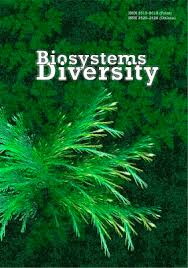Changes in the structure and dominance of the zooplankton community of the Kremenchuk Reservoir under the effect of climate changes
Changes in the structure and dominance of the zooplankton community of the Kremenchuk Reservoir under the effect of climate changes
Author(s): M. I. Khyzhniak, S. V. Kruzhylina, I. Y. Buzevych, A.V. Didenko, N. Y. Rudyk-LeuskaSubject(s): Energy and Environmental Studies, Regional Geography, Environmental Geography
Published by: Дніпропетровський національний університет імені Олеся Гончара
Keywords: water temperature; Dnieper River; abundance; biomass; saprobity; copepods; cladocerans;
Summary/Abstract: Zooplankton plays an important role in aquatic food webs and changes in its abundance and diversity under changing climatic conditions can significantly affect the abundance and diversity of other aquatic organisms. The aim of the study was to assess quantitative and qualitative parameters of zooplankton development, dynamics of development of its dominant groups and the effect of water temperature. Species composition and abundance of zooplankton of the Kremenchuk Reservoir were studied in 2006, 2010-2012 and 2020 in relation to water temperature and pollution. Zooplankton species diversity fluctuated significantly over the years of the study. A total of 46 taxa were recorded in the reservoir during the study period. The number of recorded zooplankton taxa ranged 26 to 32 depending on the year. The most abundant zooplankters were Chydorus sphaericus, Copepoda nauplii, Brachionus diversicornis. The abundance of zooplankters in the reservoir during the study period ranged 23·(10)3 to 256·(10)3 ind./m3, and biomass 0.14 to 0.89 g/m3. A significant positive relationship was observed between the abundance of cladocerans, including some individual species (Ch. sphaericus and Ceriodaphnia sp.), and water temperature. Indicator species of water pollution in different years and in different parts of the Kremenchuk Reservoir differed significantly, which probably depended on the presence or absence (in a certain period of time) of polluting discharges. The total saprobity index in different years in different parts of the reservoir was in the range of 1.5-1.9. Structural indicators of zooplankton and its dominant complexes characterize the water in the Kremenchuk Reservoir as β-mesosaprobic. It is probably too early to assess the impact of climate change zooplankton as these changes are still unstable and short in time, but it is necessary to constantly monitor the biota of aquatic eco-systems to further study and summarize the data, which could later allow an identification of such changes.
Journal: Biosystems Diversity
- Issue Year: 29/2021
- Issue No: 3
- Page Range: 217-224
- Page Count: 8
- Language: English

